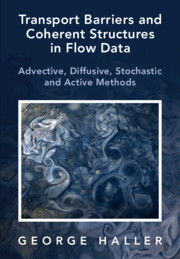 Transport Barriers and Coherent Structures in Flow Data
Transport Barriers and Coherent Structures in Flow Data Book contents
- Frontmatter
- Dedication
- Contents
- Preface
- Acknowledgments
- 1 Introduction
- 2 Eulerian and Lagrangian Fundamentals
- 3 Objectivity of Transport Barriers
- 4 Barriers to Chaotic Advection
- 5 Lagrangian and Objective Eulerian Coherent Structures
- 6 Flow Separation and Attachment Surfaces as Transport Barriers
- 7 Inertial LCSs: Transport Barriers in Finite-Size Particle Motion
- 8 Passive Barriers to Diffusive and Stochastic Transport
- 9 Dynamically Active Barriers to Transport
- Appendix
- References
- Index
2 - Eulerian and Lagrangian Fundamentals
Published online by Cambridge University Press: 20 February 2023
- Frontmatter
- Dedication
- Contents
- Preface
- Acknowledgments
- 1 Introduction
- 2 Eulerian and Lagrangian Fundamentals
- 3 Objectivity of Transport Barriers
- 4 Barriers to Chaotic Advection
- 5 Lagrangian and Objective Eulerian Coherent Structures
- 6 Flow Separation and Attachment Surfaces as Transport Barriers
- 7 Inertial LCSs: Transport Barriers in Finite-Size Particle Motion
- 8 Passive Barriers to Diffusive and Stochastic Transport
- 9 Dynamically Active Barriers to Transport
- Appendix
- References
- Index
Summary
Classical continuum mechanics focuses on the deformation field of moving continua. This deformation field is composed of the trajectories of all material elements, labeled by their initial positions. This initial-condition-based, material description is what we mean here by the Lagrangian description of a fluid motion. In contrast to typical solid-body deformations, however, fluid deformation may be orders of magnitude larger than the net displacement of the total fluid mass. The difficulty of tracking individual fluid elements has traditionally shifted the focus in fluid mechanics from individual trajectories to the instantaneous velocity field and quantities derived from it. These quantities constitutethe Eulerian description of fluids. This chapter surveys the fundamentals of both the Lagrangian and the Eulerian approaches. We also cover notions and results from differential equations and dynamical systems theory that are typically omitted from fluid mechanics textbooks, yet are heavily used in later chapters ofthis book.
Keywords
- Type
- Chapter
- Information
- Transport Barriers and Coherent Structures in Flow DataAdvective, Diffusive, Stochastic and Active Methods, pp. 13 - 59Publisher: Cambridge University PressPrint publication year: 2023
